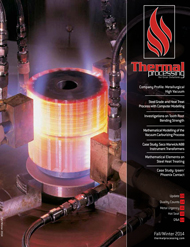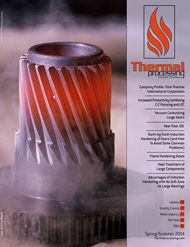Archives
September 2014
Reducing Gear Size for Compact Transmission Design by Selecting Steel Grade and Heat Treatment Process with Computer Modeling
Gears are the most important components for transmissions. In many situations, the size of a transmission design needs to be reduced without decreasing power density. One of the most effective methods is to reduce the gear size while keeping the same output torque capacity. In general, gears used in heavy load conditions are made of […]
Mathematical Modelling of the Vacuum Carburizing Process
CAs expectations regarding the quality and precision of products continue to grow, further advances in materials engineering are strictly associated with the use of computer assisted computation methods. Computer modelling and simulations facilitate the design of engineering materials and predicting the properties of these materials with significant reduction in time and costs. Thus, the literature […]
Case Study: SECO/Warwick and ABB Instrument Transformers
Instrument transformers are a precision device designed to accurately meter either current or voltage on an electrical circuit. They also provide a means to protect the metering instrumentation from the power available in the circuit. The ABB Pinetops plant is considered by ABB as its “World-wide Center of Excellence” for instrument transformers. The ABB Pinetops […]
Some Basic Mathematical Elements On Steel Heat Treating: Modeling, Freeware Packages And Numerical Simulation
Every year since 2007, in June, a Modeling Week is held within the master program of the faculty of Mathematics of Universidad Complutense of Madrid (UCM) in cooperation with the Institute of Interdisciplinary Mathematics (IIM). During this week, students work in small groups on real industrial problems proposed by companies under supervision of one or […]
Case Study: Phoenix Contact and Ipsen
Ipsen supports its equipment across the globe using the mGuard VPN router from Phoenix Contact, which allows secure remote access via the Internet. Ipsen designs and manufactures industrial vacuum furnaces (Figure 1), atmosphere furnaces, and supervisory control systems for a wide variety of thermal processing applications in the aerospace, commercial heat treating, medical, energy and […]
Investigations on Tooth Root Bending Strength of Case Hardened Gears in the Range of High Cycle Fatigue
Gears are one of the critical components that determine the capability and reliability of drive systems. Thus the tooth root load-carrying capacity is one of the determining factors in gear design. Continuous demand for higher efficiency, increased load-carrying capacity and endurance life, while at the same time, ensuring smaller size and low costs, increasingly often […]
April 2014
Advantages of Induction Hardening with No Soft Zone on Large Bearings
Large bearings are required to carry large axial and radial forces and their resulting torques. Typical applications include general machinery and construction equipment, as well as onshore and offshore energy technologies. These diverse applications have one thing in common: their components are highly stressed mechanically, and are therefore induction hardened to increase their dynamic strength […]
Increased Productivity Combining C/C Fixturing and LPC
Carbon/carbon and graphite materials are used in a variety of applications throughout the high temperature furnace industry. Entire vacuum hot zones are manufactured from these materials as well as individual components such as insulation, lining materials, nozzles, fasteners and hearth supports. Fixtures and grids are also commonly manufactured from these materials and can offer a […]
Heat Treat 101: A Primer
Gears play an essential role in the performance of many products that we rely on in our everyday lives. When we think about gears, we generally separate them into two categories: motion-carrying and power transmission. Motion-carrying gears are generally nonferrous or plastics, while load-bearing power transmission gears are usually manufactured from ferrous alloys. The focus […]
Vacuum Carburizing Large Gears
Throughout the machining process, great care is taken to achieve and maintain critical dimensions. The gears are then handed over for heat treatment. Exposing the parts to a high temperature environment, changing the material chemistry, and rapidly cooling in oil to harden is necessary to produce the high strength and long wear life expected in […]
Tooth-by-Tooth Induction Hardening of Gears (and How To Avoid Some Common Problems)
Tooth-by-tooth induction hardening of gears is a complex process. Variations of any of kind may be sufficient to cause the process to run out of control and produce gears that are out of specification. Since heat treating occurs late in the production cycle, process failure is an expensive proposition. This article highlights some of the […]
Flame Hardening Gears
Long gone are the days when a machine operator sat in a dark corner of the shop staring at the cherry red glow of a gear being flame hardened. Typically the “craftsman” would wear dark welding glasses and make the decision that the color looked good just before the water spray quench completed the hardening […]
Heat Treatment of Large Components
Large gear components can be offered in many applications such as marine, wind power, steel rolling mills, power plants, transportation, railroad, aircraft, cement crushers, mining, and oil industry applications. There are three important surface hardening methods, as seen in Figure 1, used to improve and expand the technical use of gear components. Design and material […]

























